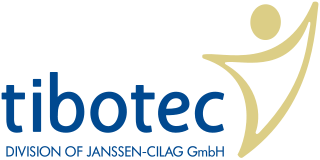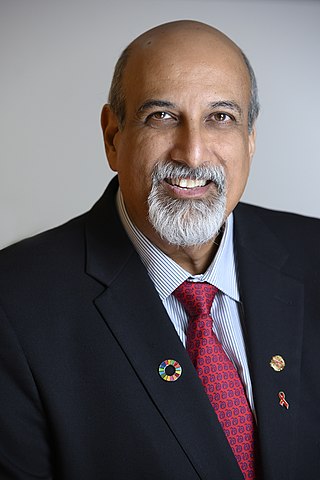
Microbicides for sexually transmitted diseases are pharmacologic agents and chemical substances that are capable of killing or destroying certain microorganisms that commonly cause human infection.

Prostratin is a protein kinase C activator found in the bark of the mamala tree of Samoa, Homalanthus nutans (Euphorbiaceae). While prostratin was originally isolated and identified as a new phorbol ester from species of the genus Pimelea (Thymelaceae) in Australia, the antiviral activity of prostratin was discovered during research on the traditional knowledge of Samoan healers in Falealupo village by ethnobotanist Paul Alan Cox and a team at the U.S. National Cancer Institute. Samoan healers use the mamala tree to treat hepatitis. Research indicated that prostratin has potential to be useful in the treatment of HIV as it could flush viral reservoirs in latently infected CD4+ T-cells.

Tibotec was a pharmaceutical company with a focus on research and development for the treatment of infectious diseases such as HIV/AIDS and hepatitis C. The company was founded in 1994 and then acquired by Johnson & Johnson and merged into its Janssen Pharmaceuticals division in 2002.
The European and Developing Countries Clinical Trials Partnership (EDCTP) is a partnership between the European Union (EU), Norway, Switzerland and developing countries and other donors, as well as the pharmaceutical industry, to enable clinical trials and the development of new medicines and vaccines against HIV/AIDS, tuberculosis, and malaria. The need for global action against these diseases in order to promote poverty reduction has been recognised by the United Nations, the G8, and the African Union, and the program envisioned the provision of €600 million for the period 2003–2007 in order to translate medical research results into clinical applications relevant to the needs of developing countries.
The Division of Acquired Immunodeficiency Syndrome (DAIDS) is a division of the National Institute of Allergy and Infectious Diseases, which is part of the National Institutes of Health. It was formed in 1986 as a part of the initiative to address the national research needs created by the advent and spread of the HIV/AIDS epidemic. Specifically, the Division's mission is to increase basic knowledge of the pathogenesis, natural history, and transmission of HIV disease and to support research that promotes progress in its detection, treatment, and prevention. DAIDS accomplishes this through planning, implementing, managing, and evaluating programs in (1) fundamental basic research, (2) discovery and development of therapies for HIV infection and its complications, and (3) discovery and development of vaccines and other prevention strategies.

Human immunodeficiency virus infection and acquired immunodeficiency syndrome (HIV/AIDS) is a spectrum of conditions caused by infection with the human immunodeficiency virus (HIV), a retrovirus. Following initial infection an individual may not notice any symptoms, or may experience a brief period of influenza-like illness. Typically, this is followed by a prolonged incubation period with no symptoms. If the infection progresses, it interferes more with the immune system, increasing the risk of developing common infections such as tuberculosis, as well as other opportunistic infections, and tumors which are rare in people who have normal immune function. These late symptoms of infection are referred to as acquired immunodeficiency syndrome (AIDS). This stage is often also associated with unintended weight loss.

Raltegravir, sold under the brand name Isentress, is an antiretroviral medication used, together with other medication, to treat HIV/AIDS. It may also be used, as part of post exposure prophylaxis, to prevent HIV infection following potential exposure. It is taken by mouth.
The Terry Beirn Community Programs for Clinical Research on AIDS (CPCRA) was a program sponsored by National Institutes of Health (NIH) in the United States. Started in 1989, CPCRA was instrumental in some research databases being established. Research from the programs assisted the evaluation of therapies for treating HIV in diverse populations.
CAPRISA 004 is the name of a clinical trial conducted by CAPRISA. This particular study was the first to show that a topical gel could reduce a person's risk of contracting HIV. The gel used in the study contained a microbicide.
Zeda Fran Rosenberg is an American microbiologist and epidemiologist, active in HIV biology and prevention. She is the chief executive officer of the International Partnership for Microbicides (IPM). IPM was founded by Rosenberg in 2002 and is a nonprofit organization dedicated to developing microbicides and other innovative HIV prevention products and making them available for women in developing countries.
CONRAD is a non-profit organization scientific research organization that works to improve the reproductive health of women, especially in developing countries. CONRAD was established in 1986 under a cooperative agreement between Eastern Virginia Medical School (EVMS) and the United States Agency for International Development(USAID). CONRAD’s products are developed primarily for women in low-resource settings, in that they are designed to be safe, affordable and user-friendly. CONRAD is led by Scientific and Executive Director Gustavo Doncel, M.D., Ph.D. Primary funding for CONRAD comes from the U.S. President's Emergency Plan for AIDS Relief (PEPFAR) through the U.S. Agency for International Development (USAID), with additional funding from The Bill & Melinda Gates Foundation and the National Institutes of Health (NIH).
HIV prevention refers to practices that aim to prevent the spread of the human immunodeficiency virus (HIV). HIV prevention practices may be undertaken by individuals to protect their own health and the health of those in their community, or may be instituted by governments and community-based organizations as public health policies.
A rectal microbicide is a microbicide for rectal use. Most commonly such a product would be a topical gel inserted into the anus so that it make act as protection against the contract of a sexually transmitted infection during anal sex.

HIV/AIDS research includes all medical research that attempts to prevent, treat, or cure HIV/AIDS, as well as fundamental research about the nature of HIV as an infectious agent and AIDS as the disease caused by HIV.

Quarraisha Abdool Karim is an infectious diseases epidemiologist and co-founder and Associate Scientific Director of CAPRISA. She is a Professor in Clinical Epidemiology, Columbia University, New York and Pro-Vice Chancellor for African Health, University of KwaZulu-Natal, South Africa.

Salim S. Abdool Karim, MBChB, MMed, MS(Epi), FFPHM, FFPath (Virol), DipData, PhD, DSc(hc) is a South African public health physician, epidemiologist and virologist who has played a leading role in the AIDS and COVID-19 pandemic. His scientific contributions have impacted the landscape of HIV prevention and treatment, saving thousands of lives
Suniti Solomon was an Indian physician and microbiologist who pioneered AIDS research and prevention in India after having diagnosed the first Indian AIDS cases among the Chennai sex workers in 1986 along with her student Sellappan Nirmala. She founded the Y R Gaitonde Centre for AIDS Research and Education in Chennai. The Indian government conferred the National Women Bio-scientist Award on her. On 25 January 2017, the Government of India awarded her the Padma Shri for medicine for her contributions towards diagnosis and treatment of HIV.

Dapivirine (DPV) Ring is an antiretroviral vaginal ring pioneered by the International Partnership for Microbicides (IPM) pending for regulatory review. It is designed as a long-acting form of HIV prevention for at-risk women, particularly in developing nations such as sub-Saharan Africa. IPM has rights to both the medication and the medical device. A total of four rings with different drug diffusion systems and polymer composition have been developed by IPM. The latest design, Ring-004, is a silicone polymer matrix-type system capable of delivering DPV intravaginally in a sustained manner.
Gita Ramjee was a Ugandan-South African scientist and researcher in HIV prevention. In 2018, she was awarded the ‘Outstanding Female Scientist’ award from the European and Developing Countries Clinical Trials Partnership. She died in Umhlanga, Durban, South Africa, from COVID-19 related complications.
Sharon Louise Hillier is an American microbiologist. She is the Richard Sweet Endowed Chair in Reproductive Infectious Disease and vice chair of the department of obstetrics, gynecology and reproductive sciences at the University of Pittsburgh Medical Center (UPMC) and Magee-Women's Research Institute.









